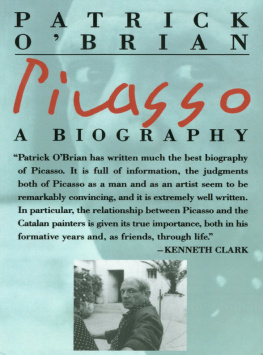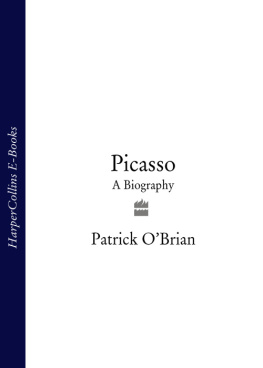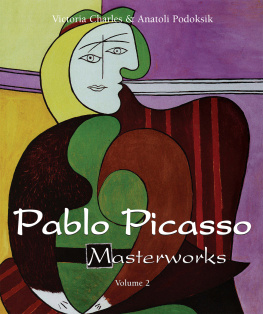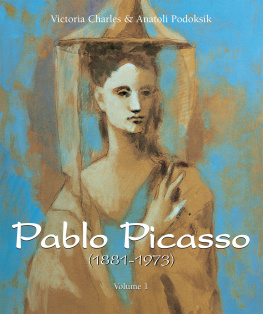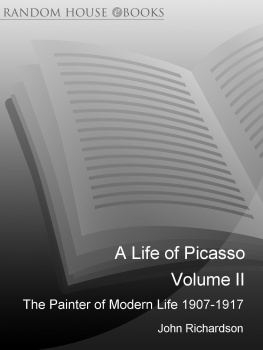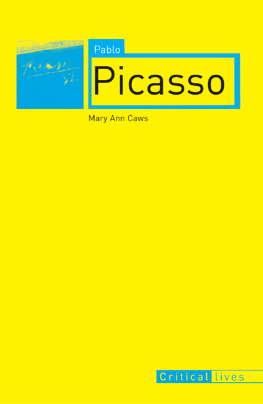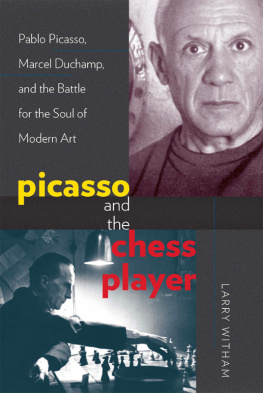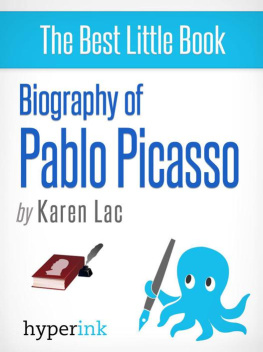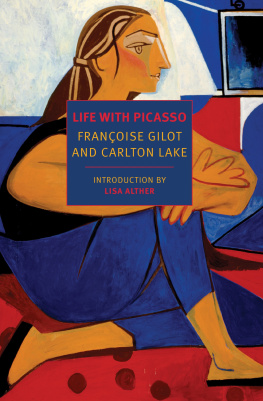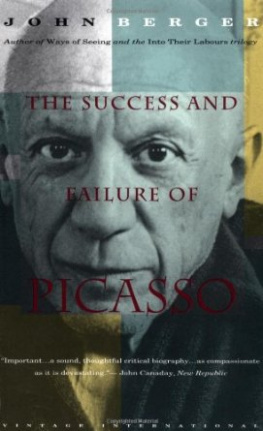OBrian Patrick - Pablo Ruiz Picasso: a biography
Here you can read online OBrian Patrick - Pablo Ruiz Picasso: a biography full text of the book (entire story) in english for free. Download pdf and epub, get meaning, cover and reviews about this ebook. City: France;Spain, year: 1994;2012, publisher: W. W. Norton & Company, genre: Detective and thriller. Description of the work, (preface) as well as reviews are available. Best literature library LitArk.com created for fans of good reading and offers a wide selection of genres:
Romance novel
Science fiction
Adventure
Detective
Science
History
Home and family
Prose
Art
Politics
Computer
Non-fiction
Religion
Business
Children
Humor
Choose a favorite category and find really read worthwhile books. Enjoy immersion in the world of imagination, feel the emotions of the characters or learn something new for yourself, make an fascinating discovery.
- Book:Pablo Ruiz Picasso: a biography
- Author:
- Publisher:W. W. Norton & Company
- Genre:
- Year:1994;2012
- City:France;Spain
- Rating:5 / 5
- Favourites:Add to favourites
- Your mark:
- 100
- 1
- 2
- 3
- 4
- 5
Pablo Ruiz Picasso: a biography: summary, description and annotation
We offer to read an annotation, description, summary or preface (depends on what the author of the book "Pablo Ruiz Picasso: a biography" wrote himself). If you haven't found the necessary information about the book — write in the comments, we will try to find it.
Pablo Ruiz Picasso: a biography — read online for free the complete book (whole text) full work
Below is the text of the book, divided by pages. System saving the place of the last page read, allows you to conveniently read the book "Pablo Ruiz Picasso: a biography" online for free, without having to search again every time where you left off. Put a bookmark, and you can go to the page where you finished reading at any time.
Font size:
Interval:
Bookmark:
P ICASSO was born on October 25, 1881, in Mlaga, the first, the only son of Doa Mara Picasso y Lopez and her husband, Don Jos Ruiz y Blasco, a painter, a teacher in the citys art school, and the curator of the local museum. The statement is true: it is to be found in all the reference-books. But perhaps it does not convey a great deal of information except to those Spaniards who can as easily visualize the Mlaga of Alphonso XIIs time as English-speaking readers can the St. Louis of President Arthurs or the Southampton of Queen Victoriasto those who know the economic, cultural, and social position of a middle-class family in that town and the pattern of life in nineteenth-century Andaluca as a whole. For even the strongest individual is indelibly marked by the culture in which he is brought up; even the loneliest man is not an island; and even Picasso carried his cradle with him to the grave. A man belongs to his own country forever, he said.
Picassos Mlaga, then, was an ancient city in the far south of Spain, an essentially Mediterranean city, and after Barcelona the countrys most important seaport on that coast: it had been a great port for centuries before Barcelona was heard of, having a natural harbor as opposed to Barcelonas open beach; but long before Picassos time the silting up of this harbor and the activity of the Catalans in building moles had reversed the position, and whereas in 1881 ships had to lie off Mlaga and discharge their cargoes into lighters, in Barcelona they could tie up in their hundreds alongside the busy quays. Yet Mlaga still had a great deal of shipping; its great bay provided shelter, and the smaller vessels could still use the harbor at the bottom of that bay, where the white town lies along the shore with the hills of Axarquia rising behind it, while the Gibralfaro rears up five hundred feet and more in the city itself, with a huge Moorish castle standing upon its top.
Compared with the booming town of the present day, the Mlaga of 1881 belonged to a different world, a world innocent of concrete and in many ways much nearer to the middle ages than to the twentieth century: tourism has changed it almost beyond recognition. When Picasso was born Mlaga still relied upon its ancient industries, shipping, cotton-spinning, sugar-refining, the working of iron, and the production of wine, almonds and raisins, and other fruit: the fertile, irrigated, subtropical plain to the west of the town supplied the cotton and the sugar-cane (the Arabs brought them to Spain) as well as oranges, lemons, custard-apples, and bananas, while the slopes behind produced almonds, the grapes for the heavy, potent wine and for the raisins; and iron-ore came from the mountains. The city of that time had only about 120,000 inhabitants as opposed to the present 375,000 (a number enormously increased by holiday-makers from all over Europe in the summer), and they lived in a much smaller space: there was little development north of the hills or beyond the river, and what is now land on the seaward side was then part of the shallow harbor. This made for a crowded, somewhat squalid city, particularly as there was little notion of drains and the water-supply was inadequate; a real city, however, with its twenty-seven churches and chapels, its four important monasteries (the survivors of a great many more before the massive suppressions, expropriations, and expulsions of 1835), its bullring for ten thousand, its still-unfinished cathedral on the site of a former mosque, its splendid market in what was once the Moorish arsenal, its garrison, its brothels, its theaters, its immensely ancient tradition, and its strong sense of corporate being. Then, as now, it had the finest climate in Europe, with only forty clouded days in the year; but in 1881 traveling in Spain was an uncommon adventure and virtually no tourists came to enjoy the astonishing light, the brilliant air, and the tepid sea. Only a few wealthy invalids, consumptives for the most part, took lodgings at the Caleta or the Limonar, far from the medieval filth and smells of the inner town. They hardly made the least impression upon Mlaga itself, which, apart from a scattering of foreign merchants, was left to the Malagueos.
Their town had been an important Phoenician stronghold until the Punic wars; then a Roman municipium; then a Visigothic city, the seat of a bishop; and then, for seven hundred and seventy-seven years, a great Arab town, one in which large numbers of Jews and Christians lived under Moslem rule. The Moslems were delighted with their conquest: they allotted it to the Khund al Jordan, the tribes from the east of the sacred river, who looked upon it as an earthly paradise. Many Arabic travelers spoke of its splendor, Ibn Batuta going so far as to compare it with an opened bottle of musk. Mlaga was a Moslem city far longer than it has subsequently been Christian, and the Arabs left their mark: even now one is continually aware of their presence, not only because of the remains of the Alcazaba, a fortified Moorish palace high over the port, and of the still higher Gibralfaro, from which the mountains in Africa can be distinguished on the clear horizon, but also because of the faces in the streets and markets and above all because of the flamenco that is to be heard, sometimes from an open window, sometimes from a solitary peasant following an ass so loaded with sugar-cane that only its hoofs show twinkling below.
The Spaniards who reconquered Andaluca came from many different regions, each with its own way of speaking; and partly because of this and partly because of the large numbers of Arabic-speaking people, Christian, Jew, and Moslem, they evolved a fresh dialect of their own, a Spanish in which the s is often lost and the h often sounded, a brogue as distinct as that of Munster: one that perplexes the foreigner and that makes the Castilian laugh. In time the Moors and the Jews were more or less efficiently expelled or forcibly converted, and eventually many of the descendants of these converts, the new Christians, were also driven from the country; but they left their genes behind, and many of their waystheir attitude towards women, for example. Then again there is a fierce democratic independence combined with an ability to live under a despotic regime that is reminiscent of the egalitarianism of Islam: no one could call the Spaniards as a whole a deferential nation, but this characteristic grows even more marked as one travels south, to reach its height in Andaluca. And as one travels south, so the physical evidence of these genes becomes more apparent; the Arab, the Berber, and the Jew peep out, to say nothing of the Phoenician; and the Castilian or the Catalan is apt to lump the Andalou in with the Gypsies, a great many of whom live in those parts. For the solid bourgeois of Madrid or Barcelona the Andalou is something of an outsider; he is held in low esteem, as being wanting in gravity, assiduity, and respect for the establishment. Mlaga itself had a solid reputation for being against the government, for being impatient of authority: it was a contentious city, in spite of its conforming bourgeoisie. In the very square in which Picasso was born there is a monument to a general and forty-nine of his companions, including a Mr. Robert Boyd, who rose in favor of the Constitution and who were all shot in Mlaga in 1831 and buried in the square; it also commemorates the hero of another rising, Riego, after whom the square was officially named, although it has now reverted to its traditional name of the Plaza de la Merced, from the church of Nuestra Seora de la Merced, which used to stand in its north-east corner. There were many other risings, insurrections, and pronunciamientos in Mlaga during the nineteenth century, including one against Espartero in 1843, another against Queen Isabella II in 1868 (this, of course, was part of the greater turmoil of the Revolution), and another in favor of a republic only eight years before Picassos birth. But although many of these risings, both in Mlaga and the rest of Spain, had a strongly anticlerical element, with churches and monasteries going up in flames and monks, nuns, friars, and even hermits being expelled and dispossessed, the Spaniards remained profoundly Catholic, and the Malagueos continued to live their traditional religious life, celebrating the major feasts of the Church with splendid bull-fights, making pilgrimages to local shrines, forming great processions in Holy Week, hating what few heretics they ever saw (until 1830 Protestants had to be buried on the foreshore, where heavy seas sometimes disinterred them), and of course baptizing their children. It would have been unthinkable for Picasso not to have been christened, and sixteen days after his birth he was taken to the parish church of Santiago el Mayor (whose tower was once a minaret), where the priest of La Merced gave him the names Pablo, Diego, Jos, Francisco de Paula, Juan Nepomuceno, Mara de los Remedios, and Cipriano de la Santsima Trinidad, together with some salt to expel the devil.
Font size:
Interval:
Bookmark:
Similar books «Pablo Ruiz Picasso: a biography»
Look at similar books to Pablo Ruiz Picasso: a biography. We have selected literature similar in name and meaning in the hope of providing readers with more options to find new, interesting, not yet read works.
Discussion, reviews of the book Pablo Ruiz Picasso: a biography and just readers' own opinions. Leave your comments, write what you think about the work, its meaning or the main characters. Specify what exactly you liked and what you didn't like, and why you think so.

